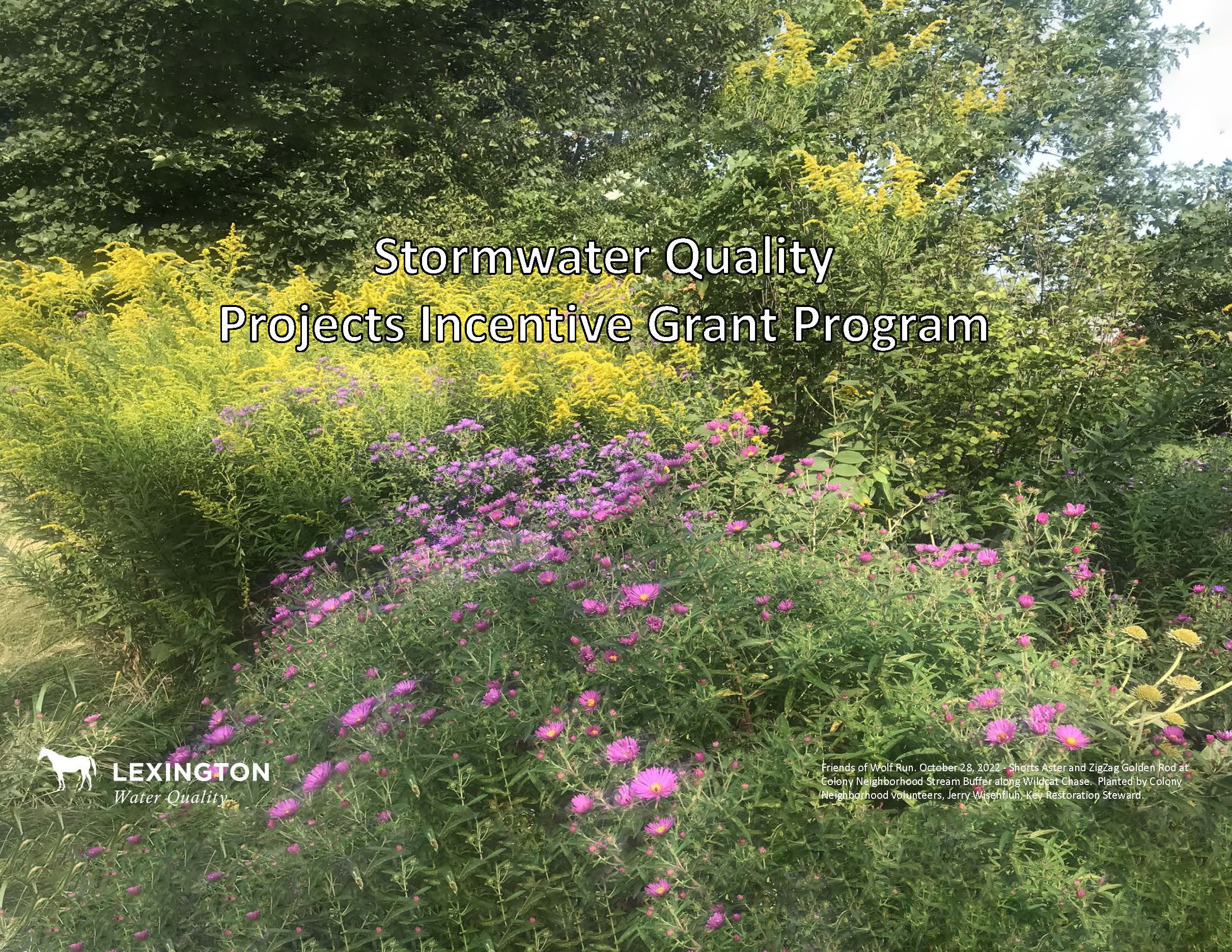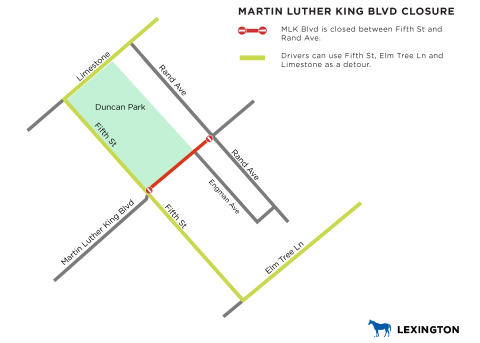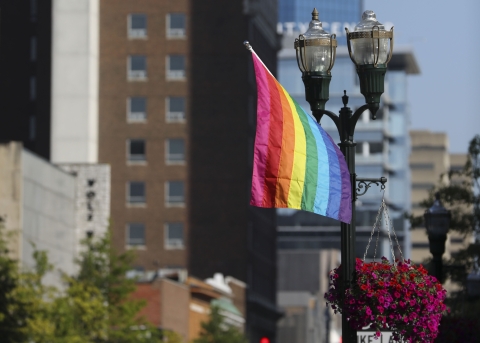
The Stormwater Quality Projects Incentive Grant Program provides financial assistance for projects that improve water quality, reduce stormwater runoff, and educate residents about stormwater and water quality issues in our community. Revenue from the Water Quality Management Fee supports this grant program.
The Water Quality Fees Board selected recipients from a pool of applicants. Each project goes before the Urban County Council for final funding approval. Descriptions for each of these projects are attached to this press release.
Through the FY23 Stormwater Quality Projects Incentive Grant Program, 18 grant recipients were awarded funds.
Six Class A grant recipients will support projects that are managed by neighborhood groups to improve stormwater in their communities. These projects include improving water quality in ponds, streamside restorations, and planting native vegetation and trees and will have a significant emphasis on educating neighbors through volunteer days and workshops.
Four Class B Education grant recipients received funding for projects such as the development of stormwater-related curriculum for schools, publicity campaigns about water quality, workshops for the public, and educational rain gardens.
Eight Class B Infrastructure grant recipients received funding to support infrastructure projects that improve water quality, such as stream restoration, constructed wetlands, bio-retention, rain gardens, rainwater harvesting, and pervious pavement installation. Two of the recipients received funding to support a feasibility study to identify, evaluate, and select BMPs for their project site.
Neighborhood Associations, Homeowner Associations, businesses, schools, churches, and non-profit organizations who are interested in starting their own stormwater improvement projects should be on the lookout for 2025 applications, which will be released next year. Applications and more information about the program can be found at lexingtonky.gov/stormwater-incentive-grant-program.
ABOUT THE FY23 GRANTS:
Class A Grants
1. Cardinal Valley Neighborhood Association (CVNA)
Grant Amount: $3,412.60
Target Watershed: Wolf Run
Grant funds to be used to maintain nine islands along Oxford Circle to enhance the visual aspects of the area. CVNA to also educate residents by hosting two cleanup/planting events and adding plant identifiers (i.e., "small garden placks") to each plant bed.
2. Friends of the Parks in Fayette County (Dogwood Park)
Grant Amount: $38,475
Target Watershed: South Elkhorn
Grant funds to be used to improve water quality in the Dogwood Trace community by implementing improvements at 2393 Dogwood Trace Blvd. The project elements include removal of invasive species, restoring and broadening riparian buffers at the spring and along the stream; and coordination with Kentucky River Watershed Watch to test stormwater quality at key locations in Dogwood Park. The project also incorporates stormwater education in the form of permanent signage and hosting two community events.
3. Friends of Wolf Run
Grant Amount: $65,520
Target Watershed: Wolf Run
The purpose of the project is to support the FY23 stream buffer stewardship program activities for Wolf Run. The objectives are to create and maintain stream buffer demonstration projects and engage neighborhood leadership in maintaining stream buffers on both public and private property. Activities include conducting stream walks, cleanup events, removal of invasive plant species, and planting of native vegetation along Wolf Run and its tributaries at various volunteer-selected stewardship sites. Furthermore, the project will provide leadership training and support, and educational outreach by communication with streamside property owners and installation of educational signage at stewardship sites.
4. Neighbors United for South Elkhorn Creek Inc.
Grant Amount: $120,000
Target Watershed: South Elkhorn
Grant funds are to be used to implement recommendations from the FY22 NUSEC Feasibility Study. The project will improve water quality in South Elkhorn Creek by reducing sedimentation from streambank erosion caused by urban stormwater runoff. Project elements include restoring eroding banks by flattening bank slopes and constructing rock toe armoring, and re-establishing and enhancing the riparian buffer zones. The project also incorporates stormwater educational tools in the form of a public involvement field day event and permanent signage that will document the stream restoration work and other project elements.
5. Walnut Hill Club at Chilesburg Owners Association, Inc.
Grant Amount: $79,500
Target Watershed: East Hickman Creek
The purpose of the project is to address ponding issues and flooding that occurs in the common grass area behind the homes on Castlebridge Lane and Donnington Court. The project elements will include regrading the common area to eliminate low spots to ensure there is positive drainage away from homes, and design and construction of a raingarden (approximately 1,000 SF) to ensure the runoff from the area is intercepted and collected inside the raingarden. The project also includes a one-time stormwater educational presentation to the neighborhood outlining the simple methods that can reduce stormwater runoff and pollution.
6. Waterford II Homeowners Association, Inc.
Grant Amount: $40,000
Target Watershed: West Hickman Creek
Grant funds will be used to complete an engineering design to replace the silted-in and failing amenity pond with a natural stream ecosystem. The project element is the design of stream restoration, riparian buffer, and floodplain vegetation areas. The project also has an educational component by developing educational signage documenting the stream restoration work and other project elements to increase the public’s awareness about the West Hickman Creek watershed.
Class B Education Grants
1. Bluegrass Greensource, Inc.
Grant Amount: $40,000
Target Watershed: Town Branch
Grant funds used to support another year-long public education and involvement campaign designed to educate and empower Lexington homeowners through improving water quality in their backyards, and PreK-12 students through direct education programming to help improve their understanding and appreciation of their role in stormwater quality. The project includes a Mini-Grant Program to equip local homeowners with funding and expertise to plant riparian buffers on backyard streams or install rain gardens on their residential lots.
2. Fayette County Public School Education Foundation Corporation Locust Trace AgriScience Center
Grant Amount $6,000
Target Watershed: Town Branch
The purpose of the project is to create a naturalized rain garden in relatively high visibility, high usage location easily accessible to existing educational programs at the Locust Trace AgriScience Center facility. The project elements include installation of a rain garden (approximately 4,000 SF) around the existing raised boardwalk outdoor classroom on campus, educational curriculum for Locust Trace Environmental Science students, and long-term maintenance of the rain garden facility and its permanent integration into the educational curriculum on campus.
3. Living Arts and Science Center, Inc.
Grant Amount: $35,296
Target Watershed: Countywide
The purpose of the project is to develop and present additional curricula and disseminate educational content utilizing established programs and LASC’s facility and grounds. The focus for FY23 will be on erosion and ecological conservation, particularly about the ways that different means of erosion control BMPs help with water conservation, water quality, and water cycles and thereby helping to sustain Kentucky wildlife. Grant funds also used to help support educational campaigns such as the Kentucky Wildlife and Wonderful interactive exhibits, an after-school ecology program for LTMS, Eco Workshops for families, Erosion Control Technologies; Kentucky Watershed and Controlled Burning; Plant Identification; and Urban Ecology. LASC continues to promote these programs and initiatives through email newsletters, social media channels, and a wide variety of printed materials, including program schedules, brochures, postcards, and flyers.
4. Providence Montessori School, Inc.
Grant Amount: $7,150
Target Watershed: Town Branch
The purpose of the project is to treat stormwater runoff with green infrastructure and reducing ponding in the existing parking located at 519 West 4th Street. The project elements include design and construction of a rock swale and rain garden. A major component of the project is the stormwater educational opportunities that allow students and teachers to be involved in the design and installation phases. Students will be engaged with the site to make observations, collect data and provide feedback. They will have the chance to choose from a selection of plants suitable for the site and work on the installation. Post-construction, students, teachers, and the grounds manager will “care for the project and perform periodic stewardship tasks”. Students will also assist with creating digital maps, measuring infiltration rates, and developing visual aids or brochures to explain the components.
Class BI Grants
1. Centenary United Methodist Church, Inc.
Grant Amount: $302,672
Target Watershed: Town Branch
The purpose of this project is to improve water quality at 2800 Tates Creek Road by mitigating deficiencies in the stormwater system by implementing stormwater infrastructure upgrades and Best Management Practices (BMPs). The project elements include the retrofit of an existing detention basin, replacement of failing infrastructure, streambank stabilization, and invasive removal. The project also includes stormwater education through a workshop and permanent signage.
2. First United Methodist Church of Lexington, Kentucky, Inc.
Grant Amount: $359,814
Target Watershed: Town Branch
Grant funds will be used to improve water quality at First United Methodist Church located at 200 West High Street. The stormwater system improvements will address flash flooding due to the lack of drainage infrastructure at the site and along the West High Street right-of-way. The project elements include retrofit of existing parking areas with permeable pavers (approximately 14,500 SF), landscaped islands and/or greenspaces (approximately 2,825 SF), and underground detention as needed. The project will also include stormwater education in the form of permanent interpretive signage.
3. Huber Real Estate No. 1, LLC
Grant Amount: $180,000
Target Watershed: Cane Run
Grant funds will be used to implement findings from the FY21 Huber Real Estate Stormwater Quality Incentive Grant Feasibility study that identified, evaluated, and selected BMPs capable of reducing the impact of pollutant loading and flooding at the 701 E 7th Street sinkhole and downstream Royal Spring Aquifer. The project elements include the installation of bioretention within the existing sinkhole footprint; revegetate overflow swale; installation of curb and gutter along the adjacent parking lot to limit sheet flow and erosion along the bank of the swale; installation of fencing around the existing sinkhole, and stormwater education.
4. LCP Holdings, LLC
Grant Amount: $20,000
Target Watershed: Town Branch
The grant will provide funds for a feasibility study to identify, evaluate, and select BMPs capable of reducing the impact of stormwater runoff onto East Vine Street from 219 E. High Street property. The project components include assessing the applicability of permeable pavement, bioretention strip, enhancement to neighboring stormwater infrastructure, and stabilization of existing stacked stone retention wall. The project also includes the feasibility of educational outreach programs (e.g. signage, professional group tours, outdoor classroom curriculum, etc.).
5. The Fayette County Public School Education Foundation Corporation
Grant Amount: $360,000
Target Watershed: Town Branch
The old Herald Leader facilities located at 100 Midland Avenue is undergoing renovations by Fayette County Public Schools as part of a project to house the combined Career and Technical Education (CTE) Programs. Grant funds will be used to install permeable pavers in lieu of traditional asphalt. The project also includes underground detention that will be connected to existing stormwater infrastructure, and stormwater education through broadcasting/Media Arts to create related Public Service Announcements, documentaries (docuseries), or new coverage on stormwater issues. The CTE building will offer educational classes to students in the Carpentry, Firefighting, Aviation, and Heavy Equipment Programs where the project elements can be incorporated into the curriculum.
6. Windswept Ventures, LLC
Grant Amount: $316,564.80
Target Watershed: Cane Run
This project will implement the FY21 United Landscape Services, Inc., Feasibility Study which identified, evaluated, and selected locations for BMPs and cost estimates for construction and future maintenance expenses. The project elements include the design and construction of a bioswale, bioretention, permeable pavers, a vegetated roof, and the removal of some existing asphalt areas. The project also incorporates stormwater education in the form of interpretive signage to be installed along Legacy Trail providing an opportunity for public awareness of sustainable stormwater methods.
7. The University of Kentucky Research Foundation
Grant Amount: $35,000.
Target Watershed: Countywide
Grant funds to be used to support a five-year plan for strategic improvement of the stormwater infrastructure across 813 acres and three watersheds through the development of a Stormwater Improvement Feasibility Study. The study will be conducted to benefit overall water quality and quantity on the campus and surrounding community. The primary deliverable of the study will be a professional recommendation building upon the existing strategic plans for stormwater management. The project also includes evaluating the potential for educational opportunities including programming and curriculum based on selected projects from the study.
8. The University of Kentucky Research Foundation
Grant Amount: $360,000
Target Watershed: Countywide
The purpose of this project is to support the University of Kentucky’s (UK) utilization of urban trees to reduce stormwater volume and improve stormwater quality through the installation of up to 30 soil cells in high-impact locations. The project has identified two sites for the soil cells, a priority location of approximately two acres of surface parking located north of Memorial Coliseum/Craft Center, and an alternate location for trees around Kroger Field. The project also has a stormwater educational component that includes integration with several academic courses and programs, research for long-term performance, and partnerships with internal and external stakeholders to provide educational workshops to the public that highlight the benefits of the tree soil cells.



